Synergistic Research Atmosphere and ATM
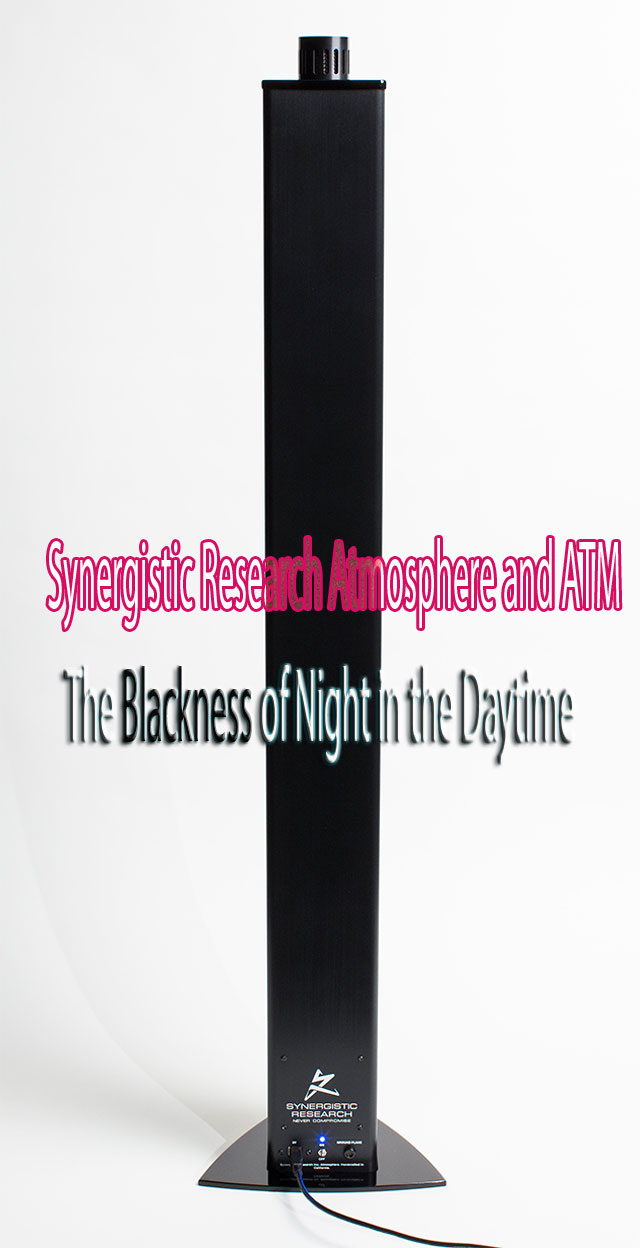
 Ted Denney, president and lead engineer at SR is constantly developing new products and revamping existing products by carrying over technology conceived for one application in the reproduction of music, applying it in a unique way, and then implementing this new breakthrough in another audio product application. This latest product known as the Atmosphere, is a room acoustic enhancement device that employs the Uniform Energy Field (UEF) technology is applied in one’s listen room by creating an optimized RF environment while working in conjunction with SR’s HFTs (review here) placed at strategic points within one’s listening room.Through multiple tuned signal generators, the RF environment is simultaneously shaped at multiply frequencies to improve the perceived soundstage with “all aspects of the sound” enhanced to one’s preference – all under control by one’s iPad/iPhone and outside the signal path.
Ted Denney, president and lead engineer at SR is constantly developing new products and revamping existing products by carrying over technology conceived for one application in the reproduction of music, applying it in a unique way, and then implementing this new breakthrough in another audio product application. This latest product known as the Atmosphere, is a room acoustic enhancement device that employs the Uniform Energy Field (UEF) technology is applied in one’s listen room by creating an optimized RF environment while working in conjunction with SR’s HFTs (review here) placed at strategic points within one’s listening room.Through multiple tuned signal generators, the RF environment is simultaneously shaped at multiply frequencies to improve the perceived soundstage with “all aspects of the sound” enhanced to one’s preference – all under control by one’s iPad/iPhone and outside the signal path.
Atmosphere began when Ted contemplated on the reason why audio systems seem to sound better late at night and worse mid-day. Ted began researching variables that could contribute to the mystery of midnight versus mid-day system performance and came to the conclusion that man-made and solar RF must play a significant role. Research began in the factors that contribute to fluctuations in the Earth’s ambient RF environment with the realization that in RF can degrade sound, then RF can be modeled and shaped to improve sound.
As quoted by Ted Denney, lead designer at SR: “In a nut shell we discovered that during the day ambient RF is stronger while the Earth’s Schumann Resonance is weaker in relation to overpowering solar and man-made radio frequencies. Typically speaking the ambient RF environment is at a higher frequency and is more complex during the day, and at a lower frequency and somewhat less complex late at night as our planet turns away from the sun. While charting Solar Flare, Coronal Hole and SDF activity we learned that the prevailing RF environment is affected by solar activity much more during the day, and less at night and this led to the discovery of specific RF environments conducive to what we perceive as good sound.
We were looking for ways to overcome the chaotic high frequency RF environment of day and replace it with the soothing lower frequency environment we experience at night. While working to recreate the perfect RF environment we built a single ELF field generator and like so many others found the Schumann Resonance, 7.83 Hz, to be a powerful talisman against high frequencies generated by solar activity as well as man-made factors like cell phones, Wi-Fi, lighting, and radio. We also found the Schumann Resonance to have significant limitations. Generate 7.83 Hz one way and sound was improved but also ‘darker’ like switching from an open sounding cable to a darker sounding cable that warms a system as it steals resolution in equal measure. Generate 7.83 Hz another way and the sound opened up but at the expense of low frequency weight and control. In other words broadcast the same frequency in two different ways and you get two different results with neither being exactly right.
The observed differences created by a single ELF generator eventually led to broadcasting over multiple separately tuned ELF and SLF generators. By working with multiple frequencies and variables we effectively sidestepped the inherent tradeoff of single frequency conditioning. With multiple tuned generators we were able to create an RF environment without tradeoffs by shaping multiple frequencies instead of relying on a single generator operating at a single frequency. What we never expected as we experimented with multiple signal generators was the realization that we were affecting, all aspects of sound.
As we continued to alter the output parameters of our multi wave generators we found we could control soundstage width, depth, and height. We also found we could shift perceived frequency balance making sound warmer or more open at will. Likewise we could control low frequencies making them sound fuller or tighter. Mid-range was also within our control allowing us to match the perceived mid-range of our systems to better compliment a given recording. By shaping literally millions of potential settings for Atmosphere we can place a performer in-between a set of speakers or when recordings calls for something massive like a full orchestra, we can ensure the room and system are capable of projecting a massively layered soundscape. It was not long before we had cataloged dozens of what we were now callings ‘scenes’ to better match different types of music.”
Atmosphere and Atmosphere Tuning Module
The Atmosphere, a Bluetooth device, is a dual channel Ultra Low Frequency / Low Frequency RF generator. With the addition of the Atmosphere Tuning Module (ATM), the output of the Atmosphere can be adjusted in to achieve over a million combinations that, when installed in a system, can complement all types of music. The Atmosphere measures 40 inches tall and is said to perform its best when centered behind the front baffle of your main speakers. Operation of the Atmosphere is through an Ipad application that is downloaded from the Apple website where different Scene or settings controls the RF output. For the best results, the Atmosphere requires a minimum Level 3 state of HFT implementation but benefits as more HFT’s are added into one’s system.
In this review, I will begin by evaluating both the Atmosphere and its three default RF Environments known as Scenes. Later, I will swap in the Red Atmosphere Tuning Module to determine what this product brings to the table.
There are 3 Scenes or RF environment shaped sonic settings in the Atmosphere iPad app that include “Intimate Acoustic”, “Holographic”, and “Grand Canyon”:
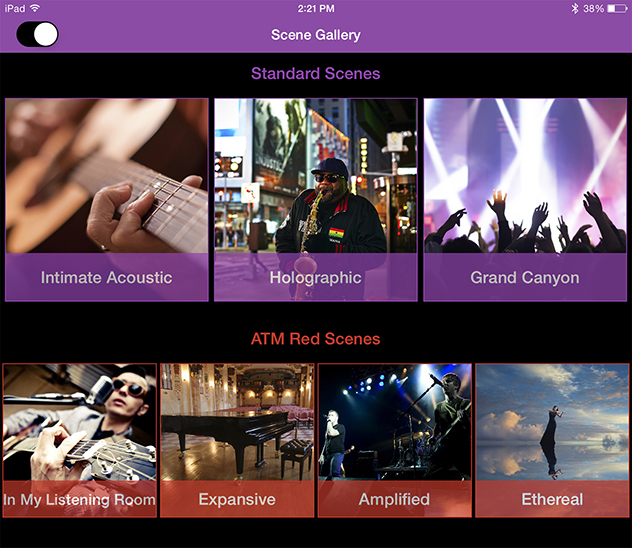
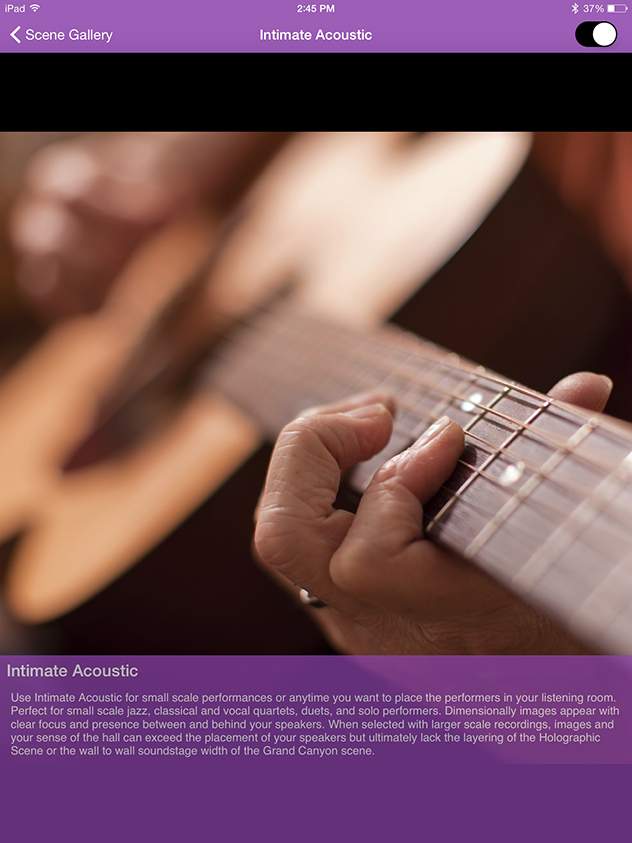
Intimate Acoustic
I found the “Intimate Acoustic” Scene to be best suited when you want to place the performers in your listen room resulting in dimensional images with a clear focus and presence on types of music consisting of small scale jazz, classical and vocal quartets, duets, and solo performers. One of my favorite reference recording I like to use to evaluate components is from Damien Rice, O (Vector Recordings/Warner Brothers Inc). On his debut album, the Irish composer pushes boundaries in several directions of folk genre which revolve around life and love while largely producing the album himself as a home recording. Since the recording venues on this album are mainly home-recorded, I thought the“Intimate Acoustic” scene would be a good choice to showcase how the Atmosphere transforms this unique set of recordings. On the seventh cut, “Cheers Darlin”, the percussion, clarinet, and vocals displayed greater presence and projected well into the room with the Atmosphere and on the eighth cut, “Cold Water,” it was easy to distinguish the change in the size and character of the acoustic space from the former recording. On both cuts, instruments had greater focus and displayed more complex textures and overtones adding to the reproduction of these recordings in my listening room. Sans the Atmosphere, the acoustic space receded to the front plane of the speakers, a slight edge was heard with the instruments less defined. The performance of my system on various cuts from this album, was also less captivating when the Atmosphere was removed from the mix.
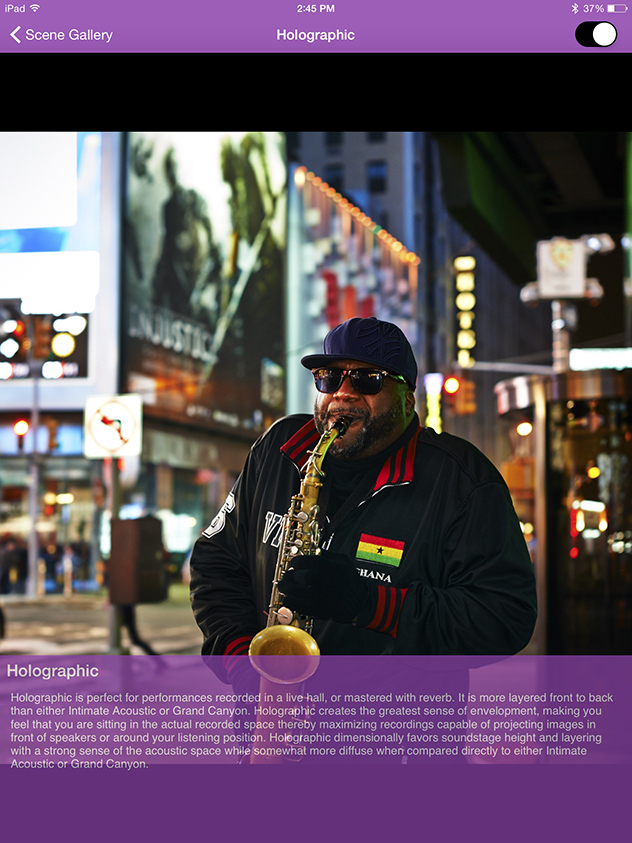
Holographic
When comparing the three default scenes, the “Holographic” Scene was preferred on performances that were recorded in a live hall or mastered with reverb. Since the John Lee Hooker, “Early one morning” (Virgin Records) recording has both aspects of being recorded in a live hall mastered with reverb, I picked this cut to showcase what the Holographic Scene adds to the mix so to speak. The Holographic Scene added greatly to the expanding the soundstage bloom and layering that projected forward from the front plane of my AZ Crescendo loudspeakers. The vocal by John Lee Hooker and electric organ and guitar displayed within the expanded acoustical space, had more presence and was more natural sounding with a greater sense of the acoustic space. The music seemed to flow so much better. Turning off the Atomosphere resulted in instrumental images losing their spatial definition, clarity and holographic presence receded. Without the Atmosphere, my system became less involving and this great recording sounded ordinaryin comparison.
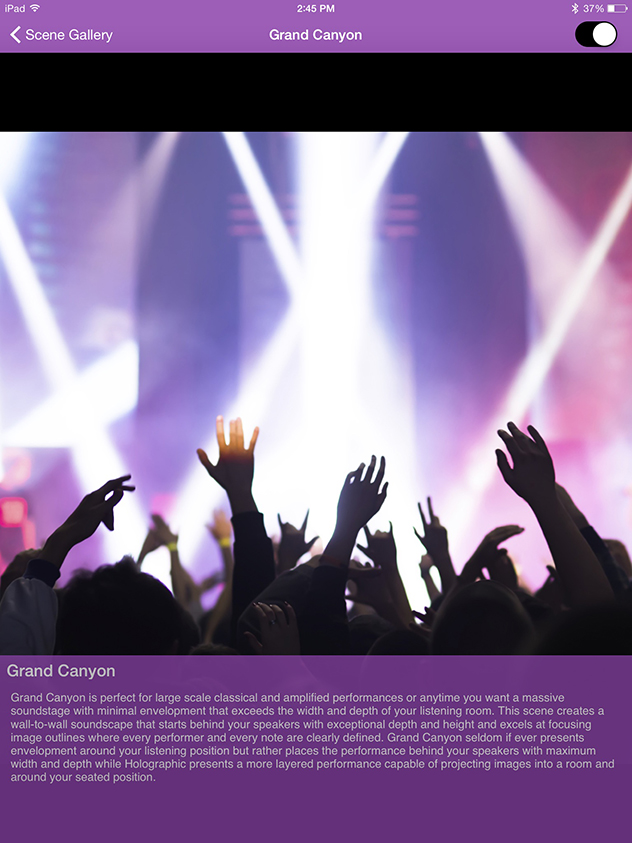
Grand Canyon
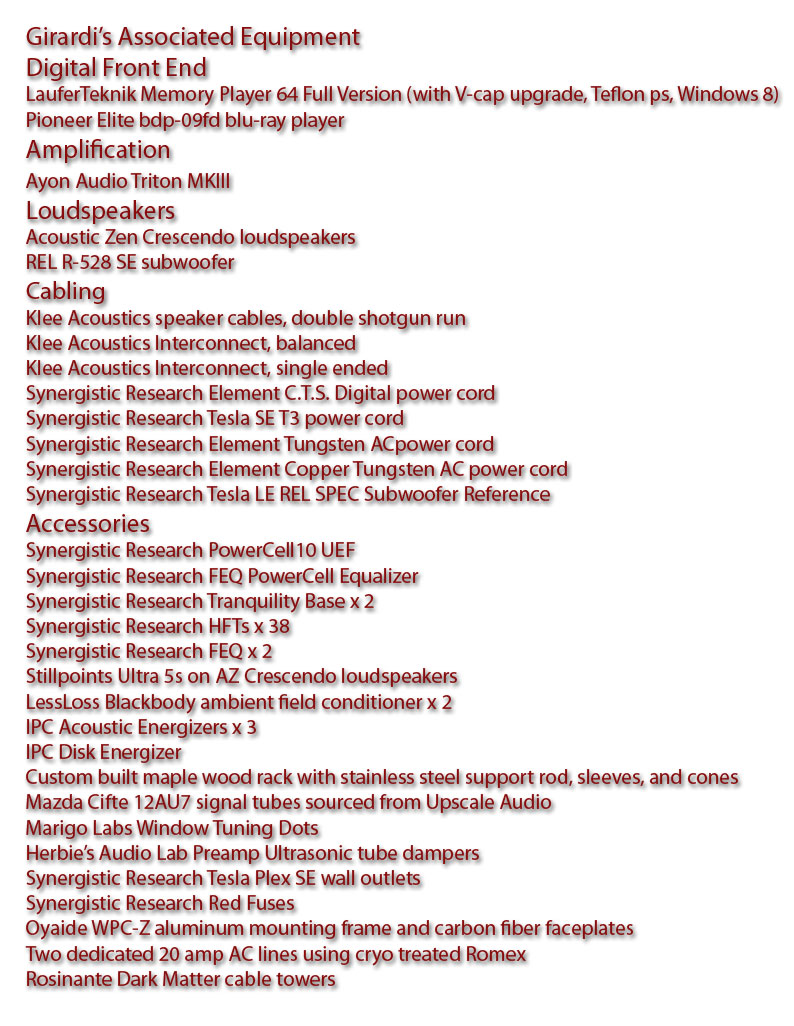 In my evaluation of the “Grand Canyon” Scene, I found it can be applied to all genres of music and works so well with any of my classical reference recordings. Given the versatility of the “Grand Canyon” Scene, I had difficulty selecting the recording to base my review on. In the end, I chose the Reference Recording’s Minnesota Ports of Call, track five Jacques Ibert’s Escales Anime, given the size of the recording venue and the many instruments comprising the recording mix. Of the three default Scenes evaluated this far, I determined that the “Grand Canyon” Scene had the widest soundstage and excelled at clearly defining the position of each instrument which was always in clear focus. The difference with and without the Atmosphere in my system was startling. Even my wife, the non-audiophile, could pick out when the Atmosphere was energized. Without the Atmosphere, each instrument suffered a loss of depth, focus and height and was less natural sounding.
In my evaluation of the “Grand Canyon” Scene, I found it can be applied to all genres of music and works so well with any of my classical reference recordings. Given the versatility of the “Grand Canyon” Scene, I had difficulty selecting the recording to base my review on. In the end, I chose the Reference Recording’s Minnesota Ports of Call, track five Jacques Ibert’s Escales Anime, given the size of the recording venue and the many instruments comprising the recording mix. Of the three default Scenes evaluated this far, I determined that the “Grand Canyon” Scene had the widest soundstage and excelled at clearly defining the position of each instrument which was always in clear focus. The difference with and without the Atmosphere in my system was startling. Even my wife, the non-audiophile, could pick out when the Atmosphere was energized. Without the Atmosphere, each instrument suffered a loss of depth, focus and height and was less natural sounding.
I also evaluated the “Grand Canyon” Scene while watching the movie “The Imagination Game.” In the opening scene where the main character, played by Benedict Cumberbatch, is providing narration, his well-articulated voice remained well focused and centered between each AZ Crescendo loudspeaker while rain and thunder appeared to be heard well behind my main loudspeakers and extended well past the side walls.
Changing between Scenes was subtle (the character of the soundstage presentation changed but the effect of the lower acoustic noise floor remained the same) but turning the Atmosphere on and off was not subtle at all. In my many evaluations, I found when power cycling the Atmosphere the RF Environment effect was not instant but slowly recede over time.
After my testing the first three default scenes, I was convinced the Atmosphere was a keeper and I wouldn’t want to listen to music without it. It was like there was a synergy going on with all the SR UEF technology present in my system, as I added more UEF technology, the improvements were additive. When I swapped the new SR Atmosphere signal cables (the first SR signal cables to use the UEF technology) into my system for a brief trial, the additive “synergistic” effect was magnified and changing between the three default Scenes was not subtle at all. Stay tuned for my upcoming reviews of the SR Atmosphere signal cables and Grounding Block.
The Atmosphere Tuning Module (ATM)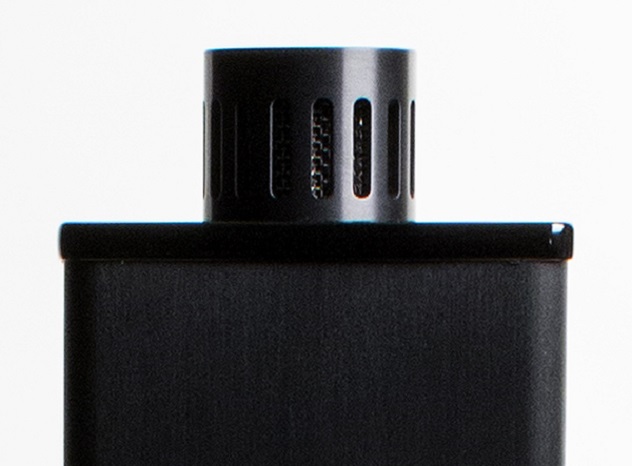
The ATM module increases the number of Scenes available to the Atmosphere. The Red ATM used in this review not only adds 4 more Scenes, but each Scene has Advanced Settings allowing one to easily fine tune the sound of one’s system. On the bottom of cylindrical ATM, is a QR code that is scanned into the Atmosphere iPad program to unlock the Scenes of the RED ATM. The ATM is also a high power HFT (High Frequency Transducer) with vents and an inverted cone in the top of the unit. The ATM is typically placed in the recessed area on the top of Atmosphere with the Atmosphere center between one’s loudspeakers and behind the front baffle. Because my two channel system is used for music and movies, I had to position the Atmosphere off center with respect to my loudspeakers and positioned the Red ATM on the top of my equipment rack but centered between my AZ Crescendos. As you will later see, this configuration of the Atmosphere and ATM module integrated well with my system.
All four Scenes provided by the Red ATM have the ability to adjust the amplitude of the RF Environment. Selection of the “Mid-Day” setting provides the greatest effect whereas the “Late PM” setting results in the smallest amplitude. The theory behind the “Amplitude” setting is related to ambient RF field present during the day versus night with the daytime being more prevalent and complex. Over time, selection and optimization of the various Scenes and Advanced settings became almost second nature.
The Red ATM provides four additional Scenes: In My Listening Room, Expansive, Amplified, and Ethereal.
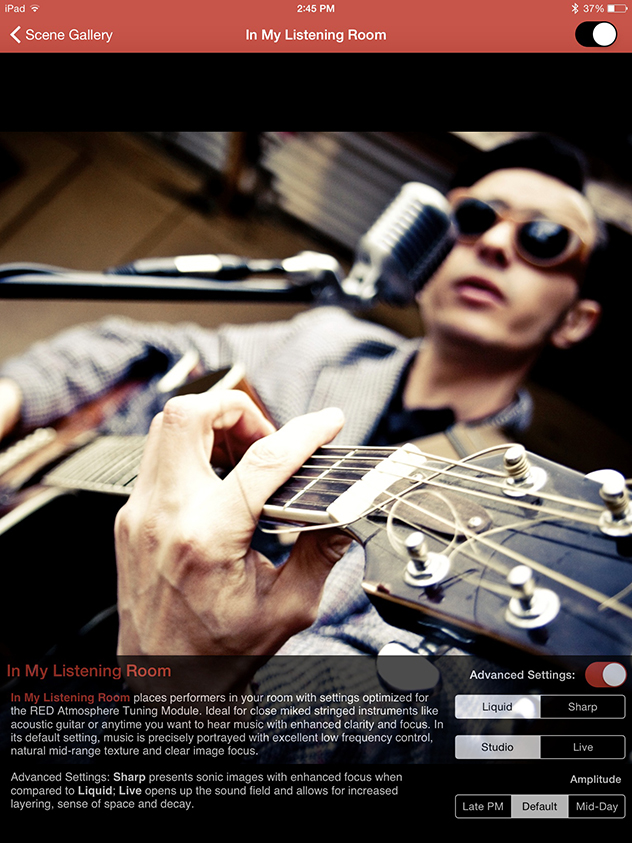
In My Listening Room
According to the SR website, the “In My Listening Room” Scene places performers in your room with settings optimized for close mic’d string instruments like guitar or when you wish to hear music with enhanced clarity and focus. Refer to the SR website for additional information related to the various Advanced Settings and their associated effects on the soundstage and imaging.
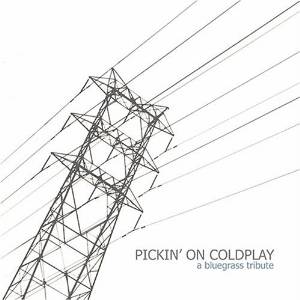 Since ColdPlay, Pickin’ on ColdPlay a bluegrass tribute (CMH Records) is a recording with close mic’d guitars, the “In My Listening Room” scene was selected to showcase how the Atmosphere could improve the presentation of this recording. Listening to various cuts on through my Laufer Teknik MP64, I came to appreciate just how much I preferred my system treated by the Atmosphere. The various guitars in this recording had greater transparency with their position within the soundstage more clearly defined with the “Sharp” and “Studio” advanced settings selected. Sans the Atmosphere, the pitch control, image focus and naturalness suffered as well as my involvement in the music. In comparison to all other ATM Scenes, I found this Scene to more closely match the main characteristics of my listening room.
Since ColdPlay, Pickin’ on ColdPlay a bluegrass tribute (CMH Records) is a recording with close mic’d guitars, the “In My Listening Room” scene was selected to showcase how the Atmosphere could improve the presentation of this recording. Listening to various cuts on through my Laufer Teknik MP64, I came to appreciate just how much I preferred my system treated by the Atmosphere. The various guitars in this recording had greater transparency with their position within the soundstage more clearly defined with the “Sharp” and “Studio” advanced settings selected. Sans the Atmosphere, the pitch control, image focus and naturalness suffered as well as my involvement in the music. In comparison to all other ATM Scenes, I found this Scene to more closely match the main characteristics of my listening room.
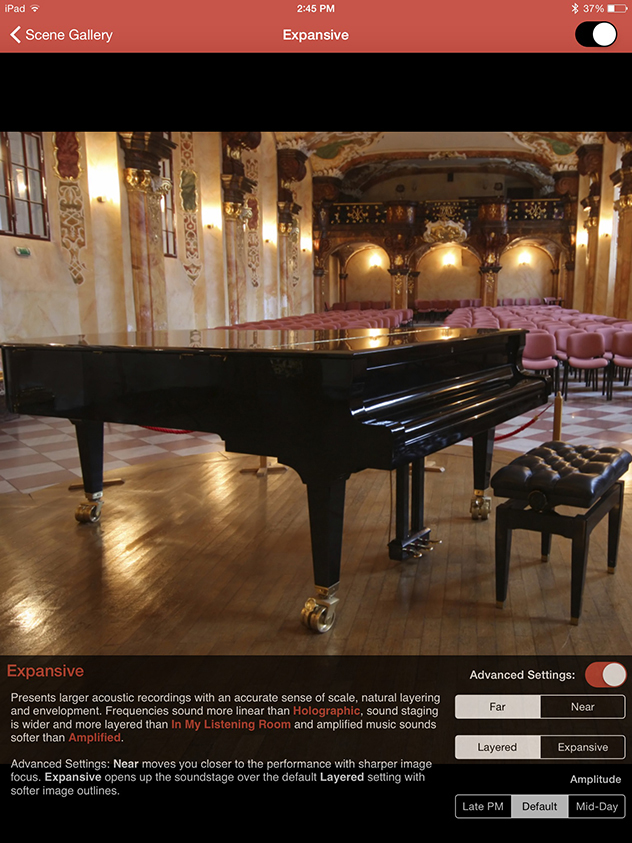
Expansive
According to the SR website, the “Expansive” Scene presents larger acoustic recordings with an accurate sense of scale, natural layering, and sound field envelopment. Refer to the SR website for additional information related to the various Advanced Settings and their associated effects on the soundstage and imaging and how the various Scenes are said to compare to each other.
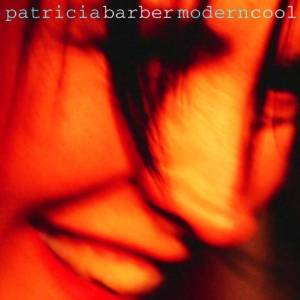 The “Expansive” Scene had the widest application based on my music tastes. I used Patricia Barber “Modern Cool” (Premonition Records) to evaluate the “Expansive” Scene. As compared to the “Holographic” Scene reviewed above, the tonal balance was unchanged when the Atmosphere was used. Patricia Barber’s vocals had greater dimension, the low end pitch definition was tighter, and the space between instruments expended well into my listening room on this recording. The cymbals where heard well past my back wall with the “Far” and “Layered” advanced settings selected. The goose bump factor on this recording dived when the Atmosphere was turned off.
The “Expansive” Scene had the widest application based on my music tastes. I used Patricia Barber “Modern Cool” (Premonition Records) to evaluate the “Expansive” Scene. As compared to the “Holographic” Scene reviewed above, the tonal balance was unchanged when the Atmosphere was used. Patricia Barber’s vocals had greater dimension, the low end pitch definition was tighter, and the space between instruments expended well into my listening room on this recording. The cymbals where heard well past my back wall with the “Far” and “Layered” advanced settings selected. The goose bump factor on this recording dived when the Atmosphere was turned off.
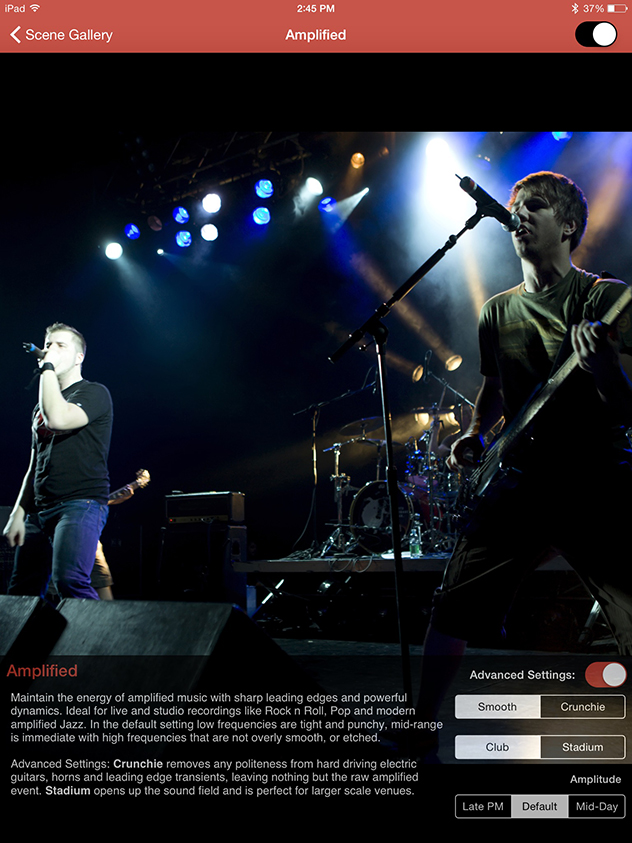
Amplified
When comparing the various ATM Scenes, I found the energy of amplified music with sharp leading edges and extreme dynamics common in some Rock ‘n’ roll, pop, and modern amplified jazz recordings, is best served by the “Amplified” Scene. I listened to track 14, The Maker, from Dave Mathews and Tim Reynolds, “Live at Radio City” (RCA) starts with two electric guitars played by Dave Mathews and Tim Reynolds with the “Amplified” Scene selected. The Advanced setting defined as “Crunchie” clearly added bite to the sound on both guitars that displayed sharper leading edges with each pluck. With the Atmosphere de-engergized, the dynamics and low frequency pitch definition of the recording receded. Based on my music preferences, this Scene was least preferred as compared to all other Scenes.
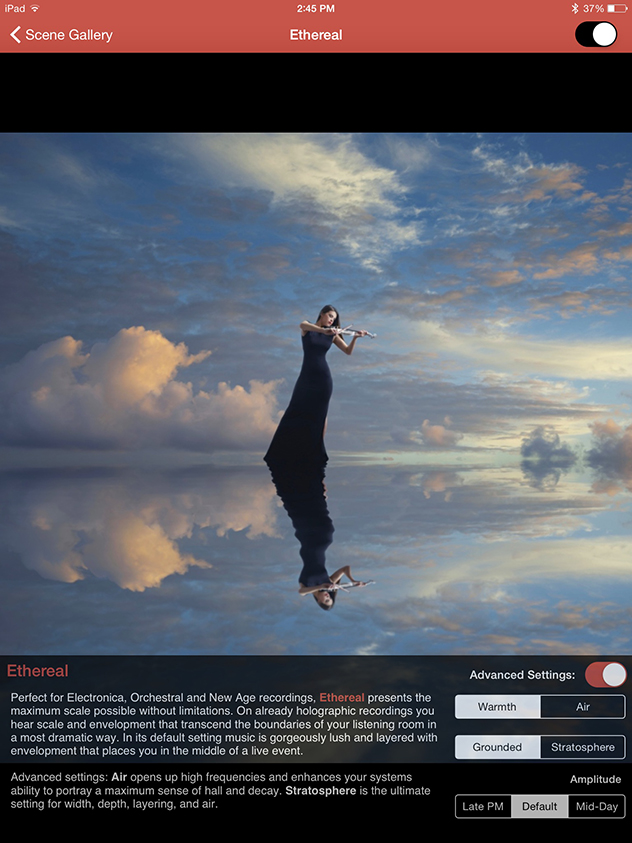
Ethereal
Given the “Ethereal” Scene was designed to present the maximum scale possible for electronica, orchestral, and new age recordings (per the SR website), I chose Roger Waters, “Amused to Death” (Columbia) to evaluate the effect of the “Ethereal” Scene in the default mode. It was easy to hear the difference with and without the Atmosphere present in my system. The room boundaries seemed to disappear while portraying a surround sound (you are there) effect with this Scene. The space between Roger Waters and the growling tiger on the first cut nearly doubled in my listening room. The edge and smear on vocals and instruments was reduced significantly. On the third cut, with the Advanced Setting, “Air” the lightning storm was fully present in the room (back to front wall) with crickets heard in the background and the organ played midway through this cut went from being present along the right side wall to an instrument occupying three dimension space. Without the Atmosphere present in my system, the soundfield collapsed to an area behind my loudspeakers and a slight edge to the vocals returned.
Conclusion
It’s rare to find a tweak that is not in the signal path to have such a profound effect on music reproduction. Once you hear the Atmosphere and how it can affect the music and the listener, you’ll be hard pressed to take it out of your system. Adding the ATM adds improves upon the original intent by adding Advanced Settings which further elevates the overall performance. The combination of the Atmosphere and ATM delivers on its promised performance and showed itself as an essential upgrade to my reference system. Now with the Atmosphere and ATM in my system to stay, critical music listening is possible day or night. Highly recommended.


Mike Girardi
Atmosphere, $2250
Atmosphere Tuning Module (RED), $495
Website: www.synergisticresearch.com
Phone numbers: (800) 578-6489 within US and (949) 476-0000 outside the US
Stereo Times Masthead
Publisher/Founder
Clement Perry
Editor
Dave Thomas
Senior Editors
Frank Alles, Mike Girardi, Key Kim, Russell Lichter, Terry London, Moreno Mitchell, Paul Szabady, Bill Wells, Mike Wright, Stephen Yan, and Rob Dockery
Current Contributors
David Abramson, Tim Barrall, Dave Allison, Ron Cook, Lewis Dardick, Dan Secula, Don Shaulis, Greg Simmons, Eric Teh, Greg Voth, Richard Willie, Ed Van Winkle, and Rob Dockery
Music Reviewers:
Carlos Sanchez, John Jonczyk, John Sprung and Russell Lichter
Site Management Clement Perry
Ad Designer: Martin Perry






Be the first to comment on: Synergistic Research Atmosphere and ATM